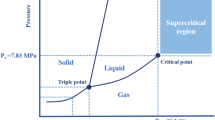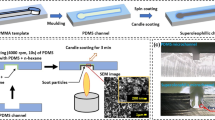Abstract
The use of supercritical carbon dioxide (scCO2) as an apolar solvent has been known for decades. It offers a greener approach than, e.g., hexane or chloroform, when such solvents are needed. The use of scCO2 in microsystems, however, has only recently started to attract attention. In microfluidics, the flow characteristics need to be known to be able to successfully design such components and systems. As supercritical fluids exhibit the exciting combination of low viscosity, high density, and high diffusion rates, the fluidic behavior is not directly transferrable from aqueous systems. In this paper, three flow regimes in the scCO2–liquid water two-phase microfluidic system have been mapped. The effect of both total flow rate and relative flow rate on the flow regime is evaluated. Furthermore, the droplet dynamics at the bifurcating exit channel are analyzed at different flow rates. Due to the low viscosity of scCO2, segmented flows were observed even at fairly high flow rates. Furthermore, the carbon dioxide droplet behavior exhibited a clear dependence on both flow rate and droplet length.








Similar content being viewed by others
References
Amon A, Schmit A, Salkin L, Courbin L, Panizza P (2013) Path selection rules for droplet trains in single-lane microfluidic networks. Phys Rev E 88:013012
Assmann N, Kaiser S, von Rohr PR (2012) Supercritical extraction of vanillin in a microfluidic device. J Supercrit Fluids 67:149–154
Barnea D, Luninski Y, Taitel Y (1983) Flow pattern in horizontal and vertical two phase flow in small diameter pipes. Can J Chem Eng 61:617–620
Baroud CN, Gallaire F, Dangla R (2010) Dynamics of microfluidic droplets. Lab Chip 10(16):2032–2045
Blanch-Ojea R, Tiggelaar RM, Pallares J, Grau FX, Gardeniers JGE (2012) Flow of CO2–ethanol and of CO2–methanol in a non-adiabatic microfluidic T-junction at high pressures. Microfluid Nanofluidics 12:927–940
Carlson A, Do-Quang M, Amberg G (2010) Droplet dynamics in a bifurcating channel. Int J Multiph Flow 36(5):397–405
Engl W, Roche M, Colin A, Panizza P (2005) Droplet traffic at a simple junction at low capillary numbers. Phys Rev Lett 95:208304
Georgiadis A, Maitland G, Trusler JPM, Bismarck A (2010) Interfacial tension measurements of the (H2O + CO2) system at elevated pressures and temperatures. J Chem Eng Data 55(10):4168–4175
Guillaument R, Erriguible A, Aymonier C, Marre S, Subra-Paternault S (2013) Numerical simulation of dripping to jetting in supercritical fluids/liquid micro coflows. J Supercrit Fluids 81:15–22
Guillot P, Colin A (2005) Stability of parallel flows in a microchannel after a T junction. Phys Rev E 72:066301
Herrero M, Mendiola JA, Cifuentes A, Ibáñez E (2010) Supercritical fluid extraction: recent advances and applications. J Chromatogr A 1217(16):2495–2511
Lee ML Markides KE (1990) Analytical supercritical fluid chromatography and extraction. Chromatography Conf. Inc., ISBN 0-8425-2394-4
Linstrom PJ, Mallard WG (2014) NIST Chemistry WebBook, NIST Standard Reference Database Number 69, National Institute of Standards and Technology, Gaithersburg MD, 20899. http://webbook.nist.gov. Retrieved 13 Feb 2014
Liu N, Aymonier C, Lecoutre C, Garrabos Y, Marre S (2012) Microfluidic approach for studying CO2 solubility in water and brine using confocal Raman spectroscopy. Chem Phys Lett 551:139–143
Marre S, Aymonier C, Subra P, Mignard E (2009) Dripping to jetting transitions observed from supercritical fluid in liquid microcoflows. Appl Phys Lett 95:134105
Marre S, Roig Y, Aymonier C (2012) Supercritical microfluidics: opportunities in flow-through chemistry and materials science. J Supercrit Fluids 66:251–264
Nightingale AM, deMello JC (2013) Segmented flow reactors for nanocrystal synthesis. Adv Mater 25:1813–1821
Ohashi A, Sugaya M, Kim H-B (2011) Development of a microfluidic device for measurement of distribution behaviour between supercritical carbon dioxide and water. Anal Sci 27:567–569
Ribatski G (2013) A critical overview on the recent literature concerning flow boiling and two-phase flows inside micro-scale channels. Exp Heat Transf 26(2–3):198–246
Squires TM, Quake SR (2005) Microfluidics: fluid physics at the nanoliter scale. Rev Mod Phys 77(3):977–1026
Tammisola O, Lundell F, Söderberg LD (2011) Effect of surface tension on global modes of confined wake flows. Phys Fluids 23:014108
Yue J, Luo L, Gonthier Y, Chen G, Yuan Q (2008) An experimental investigation of gas–liquid two-phase flow in single microchannel contactors. Chem Eng Sci 63:4189
Author information
Authors and Affiliations
Corresponding author
Rights and permissions
About this article
Cite this article
Ogden, S., Bodén, R., Do-Quang, M. et al. Fluid behavior of supercritical carbon dioxide with water in a double-Y-channel microfluidic chip. Microfluid Nanofluid 17, 1105–1112 (2014). https://doi.org/10.1007/s10404-014-1399-6
Received:
Accepted:
Published:
Issue Date:
DOI: https://doi.org/10.1007/s10404-014-1399-6




